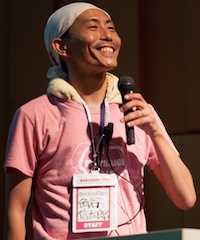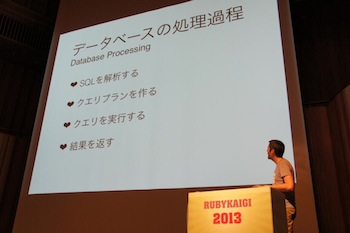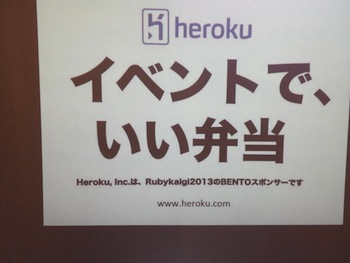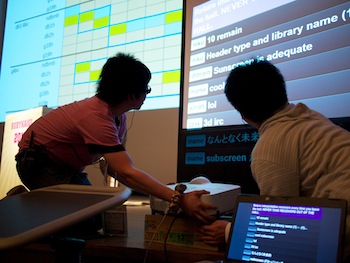RubyKaigi: Making a Japanese Conference Accessible to the World
Note: I co-wrote this article with Chris Salzberg, an Canadian Rubyist living in Japan who attended RubyKaigi.

For the first time, RubyKaigi offered simultaneous
translation from Japanese to English
RubyKaigi is the largest Ruby conference in Japan, Ruby’s home country. It was started in 2006 as a Japanese-only conference; that year David Heinemeier Hansson was the only non-Japanese presenter. But gradually year by year RubyKaigi gained more and more foreign attendees and content. This year, after a two year hiatus, RubyKaigi was reinvented and has become more international than ever. In fact, for the first time much of the conference’s content was translated live from Japanese to English.
But what does it mean to translate a conference, exactly? How did the conference organizers do it? Did it work? What did foreign attendees think? Did they get anything out of the conference? From a distance, I was fascinated!

Shintaro Kakutani (Kakutani-san) lead
the team organizing RubyKaigi 2013
To find out more, Chris and I decided to talk with Shintaro Kakutani, the principal organizer of the conference. He and his team used some innovative techniques to translate the Japanese content into English, making the conference more accessible and fun than ever. We also spoke with a couple of foreign Rubyists who attended the conference to see how well the translation worked for them.
What was different about this year’s RubyKaigi?
We asked Kakutani-san about what the organizers did differently at this year's event. He explained:
First off, to make it clear that we weren't organizing this event just for the Japan Ruby community, we made a point of announcing the conference in English.

A Japanese slide in Aaron Patterson’s talk
Talks were a bit more difficult. Many of the Japanese speakers, the most proficient Rubyists in Japan, would have struggled in English and the technically significant points they were trying to express would have been lost. So instead, we decided to hire professional Japanese to English interpreters to translate all Japanese talks.
There were also Japanese Rubyists such as Akira Matsuda who gave his talk in English, and non-Japanese Rubyists such as Aaron Patterson and John Foley who gave part of their talks in Japanese. I hope we have more talks like this in the future.
When we asked him about how international the conference was this year, he said:

At RubyKaigi, we always setup a world map in a lounge somewhere and get attendees to stick a Post It note on the map to show where they came from.
This year we literally had Rubyists from all corners of the world in Tokyo. The success of this aspect of this year's RubyKaigi went well beyond our expectations.
It's very important to us that when all these Rubyists from all over the world, with different backgrounds and different values, come together, they feel at home here and are able to enjoy themselves. This is something that I want to continue to improve.
Simultaneous translation
For the first time, RubyKaigi offered simultaneous translation from Japanese to English through the use of headsets. Non-Japanese attendees were able to listen to the Japanese presentations live and not miss a thing. During the conference there was some positive feedback about this on Twitter.



According to Richard, Aaron Patterson wrote this pun
in Japanese: "At the evento have a bento"
To learn more we asked Richard Schneeman, on the Ruby team at Heroku and Adjunct Professor at the University of Texas Austin, what he thought of the simultaneous translation.
Japanese talks were translated to English live. If you wanted to listen to the translation you could grab a radio headset and tune to the right channel. I spoke to Matz and Koichi before the talks and they said all Japanese presenters had to sit with the translator for an hour to show them their slides and help them with technical words. This resulted in very accurate and technical translations.
However, Richard did think some of the humor might have been lost in translation.
While not all of the jokes were translated well, all of the technical material was. The majority of the slide decks were in English, but many jokes and some other non-technical content was in Japanese.
Jim Gay, lead developer for Radiant CMS and the author of Clean Ruby, was similarly positive about the simultaneous translation.
Translation services were impressive. Professionals seemed to be translating technical terms with ease. Without this I would have been lost. I actually tried to sit through a Japanese presentation but only got a few minutes in before I decided to get the translation earphone. Several (maybe most) presentations had slides in English but presenters spoke in Japanese. This definitely helped.
The conference organizers also arranged for a projector showing an IRC channel on stage, right next to the speakers and the main presentation slides. This provided a way to crowd source the translation and also helped build a sense of community at the conference.
An open invitation!
Finally, Kakutani-san wanted us to pass along this invitation to Rubyists living outside of Japan.
RubyKaigi brings together more Ruby developers than any other conference in the world. This is an event for all Rubyists, around the world, who want to improve the Ruby language. We hope to see many more international Rubyists at the next RubyKaigi and look forward to your talks and to your support.
And there you have it: an open invitation to come to Ruby’s home country and meet the community that invented this amazing language that we all know and love. Japan may be a long way to travel, but we can rest assured we’ll be in good hands next year at RubyKaigi 2014!


